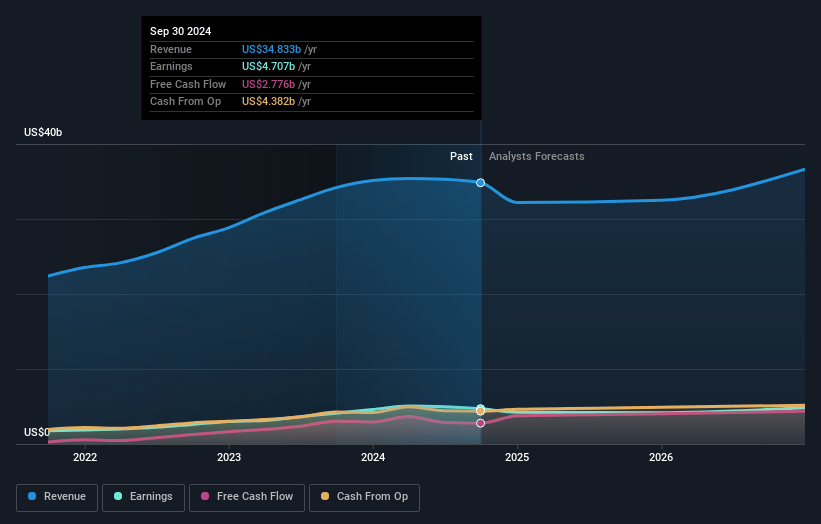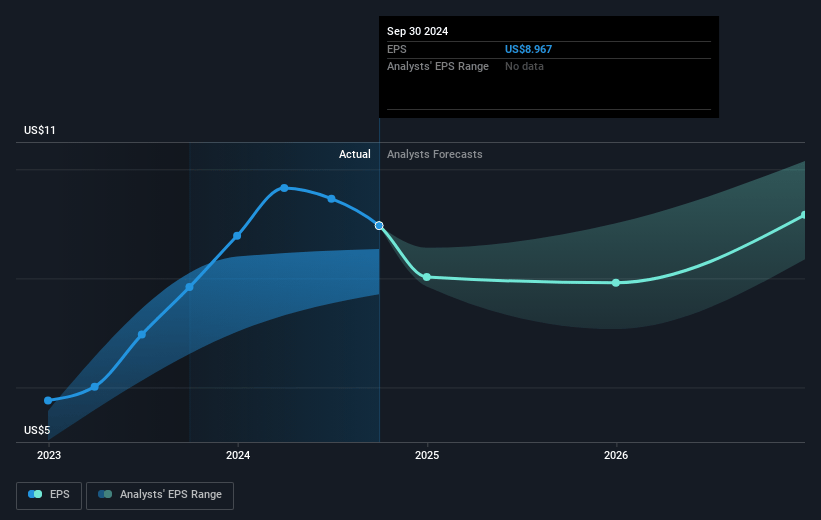Narratives are currently in beta
Key Takeaways
- Decline in production and rising costs without price adjustments could pressure net margins and revenue growth.
- Investment in capacity and technology may strain earnings if revenue growth lags these expenditures.
- PACCAR's strong financial performance and strategic investments in market share expansion, infrastructure, and innovative products position it for sustained growth and enhanced profitability.
Catalysts
About PACCAR- Designs, manufactures, and distributes light, medium, and heavy-duty commercial trucks in the United States, Canada, Europe, Mexico, South America, Australia, and internationally.
- An expected decline in production volume for the fourth quarter due to fewer production days, holidays, and supplier-related limitations could negatively impact revenue growth.
- Increasing costs without corresponding price increases, especially in the truck segment where costs were up by 3% while prices remained flat, suggesting potential pressure on net margins.
- Continued investment in manufacturing capacity and advanced technologies, with 2025 capital expenditures projected to be at least as high as 2024, could pressure earnings if revenue growth does not outpace these expenditures.
- Predictable financial performance in the Parts and Financial Services segments, where gross margins are anticipated to decline slightly by 4Q, potentially indicating squeezed margins and impacting overall earnings.
- A flat to slightly lower European market expected in 2025 and reduced deliveries in the current year due to economic factors, implying muted growth opportunities overseas, potentially impacting revenue growth.
PACCAR Future Earnings and Revenue Growth
Assumptions
How have these above catalysts been quantified?- Analysts are assuming PACCAR's revenue will decrease by 0.6% annually over the next 3 years.
- Analysts assume that profit margins will shrink from 13.5% today to 12.9% in 3 years time.
- Analysts expect earnings to reach $4.6 billion (and earnings per share of $8.57) by about November 2027, down from $4.7 billion today. However, there is some disagreement amongst the analysts with the more bullish ones expecting earnings as high as $5.7 billion.
- In order for the above numbers to justify the analysts price target, the company would need to trade at a PE ratio of 16.2x on those 2027 earnings, up from 13.0x today. This future PE is lower than the current PE for the US Machinery industry at 24.6x.
- Analysts expect the number of shares outstanding to grow by 0.54% per year for the next 3 years.
- To value all of this in today's terms, we will use a discount rate of 7.29%, as per the Simply Wall St company report.
PACCAR Future Earnings Per Share Growth
Risks
What could happen that would invalidate this narrative?- PACCAR's strong financial performance, including robust earnings of $972 million on revenues of $8.2 billion with an industry-leading after-tax return on revenue of 11.8%, suggests continuing financial health which may support share price stability or growth. (Impacts revenue and earnings)
- Increased market share in the U.S. and Canadian Class 8 market, along with gains in medium-duty market share, may strengthen PACCAR's competitive position and drive future sales and revenue growth. (Impacts revenue)
- Ongoing infrastructure investments in the vocational market, where PACCAR brands are leaders, could sustain demand for their trucks, generating steady revenue streams. (Impacts revenue)
- Strategic investments, like the expansion of manufacturing capacity and opening new distribution centers, position PACCAR for growth and enhanced operational efficiency, potentially leading to improved margins and profitability. (Impacts revenue and net margins)
- Successful product launches, including the new DAF trucks with improved fuel economy and advanced safety features, and PACCAR's focus on connected truck solutions, could drive customer demand and enhance brand value, supporting revenue growth. (Impacts revenue)
Valuation
How have all the factors above been brought together to estimate a fair value?- The analysts have a consensus price target of $112.26 for PACCAR based on their expectations of its future earnings growth, profit margins and other risk factors. However, there is a degree of disagreement amongst analysts, with the most bullish reporting a price target of $129.0, and the most bearish reporting a price target of just $89.21.
- In order for you to agree with the analyst's consensus, you'd need to believe that by 2027, revenues will be $35.5 billion, earnings will come to $4.6 billion, and it would be trading on a PE ratio of 16.2x, assuming you use a discount rate of 7.3%.
- Given the current share price of $116.8, the analyst's price target of $112.26 is 4.0% lower. The relatively low difference between the current share price and the analyst consensus price target indicates that they believe on average, the company is fairly priced.
- We always encourage you to reach your own conclusions though. So sense check these analyst numbers against your own assumptions and expectations based on your understanding of the business and what you believe is probable.
How well do narratives help inform your perspective?
Disclaimer
Warren A.I. is a tool utilizing a Large Language Model (LLM) that ingests data on consensus price targets, forecasted revenue and earnings figures, as well as the transcripts of earnings calls to produce qualitative analysis. The narratives produced by Warren A.I. are general in nature and are based solely on analyst data and publicly-available material published by the respective companies. These scenarios are not indicative of the company's future performance and are exploratory in nature. Simply Wall St has no position in the company(s) mentioned. The price targets and estimates used are consensus data, and do not constitute a recommendation to buy or sell any stock, and they do not take account of your objectives, or your financial situation. Note that Warren A.I.'s analysis may not factor in the latest price-sensitive company announcements or qualitative material.
Read more narratives
There are no other narratives for this company.
View all narratives



